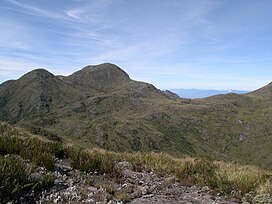| Pedra da Mina | |
|---|---|
 | |
| Highest point | |
| Elevation | 2,798 m (9,180 ft)[1] |
| Prominence | 2,068 m (6,785 ft) |
| Listing | Ultra |
| Coordinates | 22°25′S 44°51′W / 22.417°S 44.850°W |
| Geography | |
| Location | Between the towns of Queluz and Lavrinhas (São Paulo), and Passa Quatro (Minas Gerais), Brazil |
| Parent range | Serra Fina, a section of the Mantiqueira Mountains |
| Climbing | |
| First ascent |
|
| Easiest route | From the town of Passa Quatro, by a trail that starts at the rural hamlet of Paiolinho[2] |
Pedra da Mina (Portuguese pronunciation: [ˈpɛdɾɐ dɐ ˈmĩnɐ]) is the fourth highest mountain in Brazil,[Note 1] located in the Serra Fina section of the Mantiqueira Mountains, one of the country's most important mountain ranges. The mountain stands on the border of the states of Minas Gerais and São Paulo, respectively to its north and south. With a 2,798-metre (9,180-foot) elevation, it is the highest point of the Mantiqueira Mountains and of the state of São Paulo, and the second highest mountain in the state of Minas Gerais.[3]
In addition to being one of the highest Brazilian mountains, Pedra da Mina is also remarkable for its peculiar history (see below), as in spite of its high elevation and of being located relatively close to densely populated areas, until the turn of the 21st century the mountain was virtually unknown, so was its exact elevation, and its importance was not acknowledged until very recently, showing that even in the 21st century, geographical exploration may still hold surprises. In this case, official statistics and schoolbooks had to be corrected, and a new popular mountaineering and ecotourism destination appeared.[5]
Like all of Serra Fina, Pedra da Mina is composed of highly alkaline nepheline syenite, a type of rock that is easily eroded and for this reason is not usually found at very high elevations. Pedra da Mina is believed to be the highest mountain made of that type of rock in the Americas and possibly in the world.[6]
Pedra means "rock" in Portuguese; mina usually means "mine", but it can also mean "spring, water source". So, the name of the mountain means "Water Spring Rock", and it is due to the fact that four small creeks rise from the mountain close to the top.[7]
Pedra da Mina is not located in any national or state park, but it is within the Mantiqueira Mountains Environmental Protection Area, and therefore still legally protected to some extent.[8]
- ^ "Geociências: IBGE revê as altitudes de sete pontos culminantes" [Geosciences: IBGE revises the altitude of seven high points] (Press release) (in Portuguese). Brasília: Brazilian Institute of Geography and Statistics (IBGE). 2016-02-29. Retrieved 2016-04-03.
- ^ "Pedra da Mina - Trilha do Paiolinho" [Pedra da Mina - Paiolinho Trail]. Os Mochileiros na Trilha (in Portuguese). 2013-04-22. Retrieved 2016-04-03.
- ^ a b c Brazilian Institute of Geography and Statistics (IBGE) (2014). Anuário Estatístico do Brasil 2014 [2014 Statistical Yearbook of Brazil] (in Portuguese). Vol. 74. Rio de Janeiro: Brazilian Institute of Geography and Statistics (IBGE). p. 33. ISSN 0100-1299.
- ^ "Após nova medição, Pico da Neblina ganha 1,52 metros a mais" [After new measurement, Pico da Neblina becomes 1.52 metre higher]. Alta Montanha (in Portuguese). 2016-02-29. Archived from the original on 2016-07-01. Retrieved 2016-05-30.
- ^ Sapucahy, Mário L. R. (2006). O processo de turistificação da Pedra da Mina [The touristification process of Pedra da Mina] (PDF). 3rd Meeting of the Brazilian National Association of Graduate Studies and Research in Environment and Society (ANPPAS) (in Portuguese). São Paulo: ANPPAS. Retrieved 2016-04-03.
- ^ Leite, Helton Perillo Ferreira (2007). Planalto do Itatiaia [Itatiaia Plateau] (in Portuguese). Rio de Janeiro: Publit Soluções Editoriais. pp. 34–35. ISBN 978-8577730766.
- ^ "Duelo entre gigantes" [Duel of giants]. Horizonte Geográfico (in Portuguese). São Paulo: Horizonte Educação e Comunicação. 2008-11-10. Retrieved 2016-04-03.
- ^ Antônio Silveira R. dos, Santos. "Pedra da Mina, SP - MG, Brasil". A Última Arca de Noé (in Portuguese). Retrieved 2016-04-03.
Cite error: There are <ref group=Note> tags on this page, but the references will not show without a {{reflist|group=Note}} template (see the help page).
